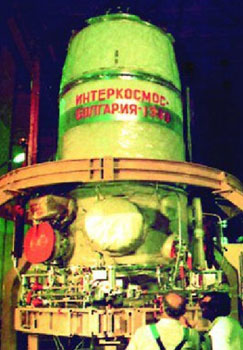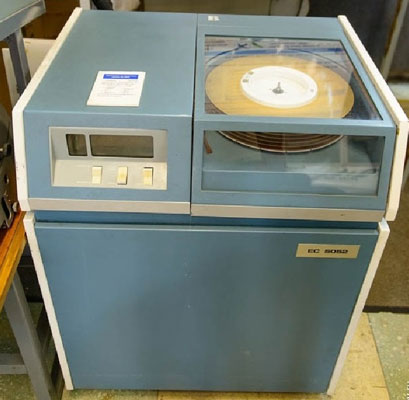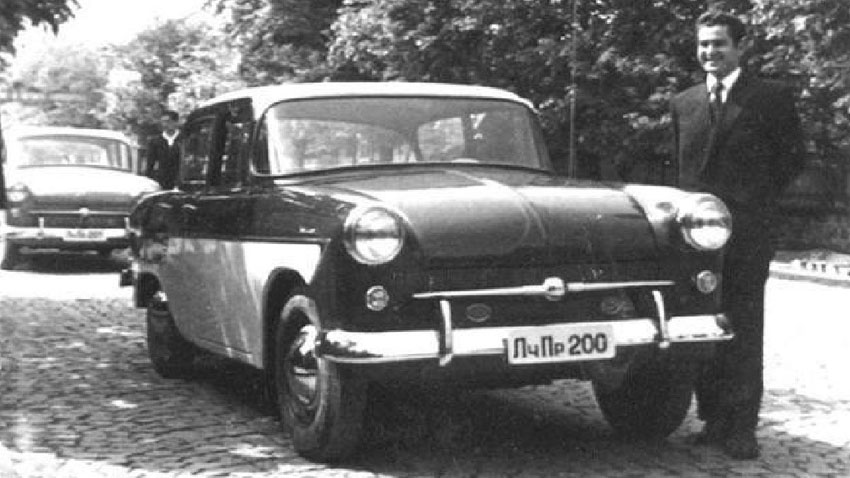Sandacite.bg is an online project for a virtual museum dedicated to old Bulgarian technical equipment. It was created in 2007 by Anton Orush. The site offers pictures, information and reference data about various Bulgarian devices produced over the years. Anton has been collecting such equipment since 2003 and has accumulated a lot of information and knowledge about the most important Bulgarian inventions of the past:
 “Bulgarian satellite ‘Intercosmos 22’ or ‘Bulgaria 1300’ as it is more commonly known, was launched on August 7, 1981. It was designed to operate at an altitude of 825 to 906 km and weighs a ton and a half. It is constructed in Bulgaria and it is based on Soviet satellite ‘Meteor’. All scientific instruments in it are Bulgarian-made. They are intended for monitoring space radiation, charged particles, cosmic plasma and various chemical processes. There are two solar panels, each generating 2 kW of power. The satellite is the result of scientific and technical cooperation between Bulgaria and the former Soviet Union. It was believed that the satellite burned in the atmosphere and could not be found. But recently it was discovered that it still orbits the Earth.”
“Bulgarian satellite ‘Intercosmos 22’ or ‘Bulgaria 1300’ as it is more commonly known, was launched on August 7, 1981. It was designed to operate at an altitude of 825 to 906 km and weighs a ton and a half. It is constructed in Bulgaria and it is based on Soviet satellite ‘Meteor’. All scientific instruments in it are Bulgarian-made. They are intended for monitoring space radiation, charged particles, cosmic plasma and various chemical processes. There are two solar panels, each generating 2 kW of power. The satellite is the result of scientific and technical cooperation between Bulgaria and the former Soviet Union. It was believed that the satellite burned in the atmosphere and could not be found. But recently it was discovered that it still orbits the Earth.”
In 1981, the1300th anniversary since the creation of Bulgaria was marked. This gave impetus to large-scale technical projects - from the design of professional and scientific equipment to the creation of new home appliances. It was not a coincidence that Bulgarian color TV "Sofia 81" emerged on the marketthat year. Under the framework of the former Council for Mutual Economic Assistance, Bulgaria specialized in the field of computing and powerful for that time computers were produced in Sofia and then exported to Africa and India.
 “The most popular of them are ES 1020, IZOT 310. A big room was needed to fit all their parts. Each of the countries within the Council for Mutual Economic Assistancewas taking part in the projects and hard drives were produced in Bulgaria. The boom was in the 70s and 80s of the twentieth century. To fulfill the obligations under the Council for Mutual Economic Assistance in 1969 and 1970 seven factories were built. They were part of state-owned company IZOT - specialised in computing and recording equipment. There were two factories for memory devices - in VelikoTarnovo and Plovdiv. The factory for nonstandard equipment was in Shumen. There was a factory for peripherals in Stara Zagora, for magnetic heads - in Razlog, as well as the "Mechatronics" plant in Gabrovo. The Computing Equipment Factory in Sofia was the major one. The first Bulgarian computer is ZIT-151, built under license for Fujitsu Facom 230-30. The entire IZOT series is a unified system of standardized modular computing machines that were used within the Eastern bloc. Some were based on the most modern machines in the world at that time- those of American company IBM. They were used in scientific, laboratory and economic practice. Just the hard drive of these machines weighs about 100-200 kilograms.”
“The most popular of them are ES 1020, IZOT 310. A big room was needed to fit all their parts. Each of the countries within the Council for Mutual Economic Assistancewas taking part in the projects and hard drives were produced in Bulgaria. The boom was in the 70s and 80s of the twentieth century. To fulfill the obligations under the Council for Mutual Economic Assistance in 1969 and 1970 seven factories were built. They were part of state-owned company IZOT - specialised in computing and recording equipment. There were two factories for memory devices - in VelikoTarnovo and Plovdiv. The factory for nonstandard equipment was in Shumen. There was a factory for peripherals in Stara Zagora, for magnetic heads - in Razlog, as well as the "Mechatronics" plant in Gabrovo. The Computing Equipment Factory in Sofia was the major one. The first Bulgarian computer is ZIT-151, built under license for Fujitsu Facom 230-30. The entire IZOT series is a unified system of standardized modular computing machines that were used within the Eastern bloc. Some were based on the most modern machines in the world at that time- those of American company IBM. They were used in scientific, laboratory and economic practice. Just the hard drive of these machines weighs about 100-200 kilograms.”
In the second half of the twentieth century a number of TVsets and radios were produced in Bulgaria.This gave the rise to the need for appropriate service equipment.The Elektronika factory in Sofia was responsible for the task after the middle of the 60s. A whole series of portable measuring devices was developed and produced there. Unlike this type of equipment, the first Bulgarian car Balkan 1200 was produced in just one place:

“It was developed in 1960 in the ‘Balkan’ factory in Lovech. A Volkswagen car was used as a model.There were blueprints in 1: 1 scale and a model made of wood was produced. The final stage of the design involved cutting the wooden model into individual parts. They were used for modelling the bodywork. The individual components of the body were created entirely by hand using wooden hammers as tin was placed on leather bags filled with sand. Hardly any professional equipment was used for the bodywork and they tried to do everything by hand, but actually succeeded and the Balkan worked.”
English: Alexander Markov
Photos: The Institute for Space Research and Technology, the Bulgarian Academy of Science, Private archive, Anton Orush and www.sandacite.bg
Every child dreams of having all the time in the world in which to play and enjoy piles of sweet delights. One of the most favorite, of course, is His Majesty the Chocolate. The first records of its appearance can be found as early as 2,000 years before..
A little over 1,450 Leva is the sum needed per month by an individual living in a one-person household, and a total of 2,616 Leva for the monthly upkeep of a three-member household - as is the most widespread model in Bulgaria at the moment (two..
The traditional "Easter Workshop" will be held from April 23 to 26 in the Ethnographic Exposition of the Regional History Museum - Pazardzhik. Specialists from the ethnographic department of the museum will demonstrate traditional techniques and..
A little over 1,450 Leva is the sum needed per month by an individual living in a one-person household, and a total of 2,616 Leva for the monthly..
Every child dreams of having all the time in the world in which to play and enjoy piles of sweet delights. One of the most favorite, of course, is His..

+359 2 9336 661
